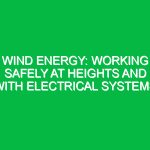Introduction
In the ever-evolving landscape of energy production, renewable energy projects stand out as a beacon of hope for a sustainable future. However, as we transition from fossil fuels to clean energy sources, the importance of safety cannot be overstated. Safety in Renewable Energy Projects is not just a regulatory checkbox; it is an essential component that ensures the health and well-being of workers, communities, and the environment. This article delves into the multifaceted realm of safety within renewable energy initiatives, exploring the various hazards, risks, best practices, and regulatory frameworks that govern this vital sector.
Understanding Safety in Renewable Energy Projects
Safety in Renewable Energy Projects encompasses a wide array of practices and protocols designed to protect individuals and the environment during the planning, construction, operation, and decommissioning of renewable energy facilities. This includes solar farms, wind turbines, hydroelectric plants, and biomass facilities, each with unique challenges and safety considerations. The relevance of safety in the Health, Safety, and Environment (HSE) domain is paramount, as it directly impacts the feasibility and success of renewable energy projects.
A personal experience from my time working on a solar installation site highlights this point vividly. During the initial phases of the project, we encountered a significant safety issue related to high winds, which posed risks to both personnel and equipment. By implementing rigorous safety protocols, including temporary barriers and weather monitoring systems, we not only mitigated these risks but also fostered a culture of safety that empowered the entire team.
Identifying Hazards and Risks in Renewable Energy Projects
Recognizing the potential hazards associated with renewable energy projects is the first step toward ensuring safety. Each type of renewable energy installation comes with its own set of risks.
1. Electrical Hazards
With solar panels and wind turbines, electrical hazards are prevalent. Workers may face risks from live wires, high-voltage systems, and malfunctioning equipment.
2. Mechanical Hazards
Mechanical equipment, such as cranes and turbines, poses risks of injuries from moving parts or equipment failure. A notable example comes from a wind farm project where a maintenance technician suffered an injury due to improper lockout/tagout procedures.
3. Falls from Heights
In projects involving tall structures, such as wind turbines, falls from heights are a significant concern. Safety harnesses and proper training are essential in these scenarios.
4. Environmental Hazards
Construction and operation can lead to environmental hazards, including soil erosion and water contamination. For instance, improper handling of hazardous materials can result in spills that harm local ecosystems.
5. Weather and Natural Conditions
Extreme weather conditions can present risks, particularly in outdoor projects. High winds, lightning, and heavy rains can not only halt operations but also endanger workers.
Safety Precautions and Best Practices
To mitigate the identified hazards, implementing robust safety precautions and best practices is crucial.
1. Comprehensive Training
Training is the backbone of safety in any renewable energy project. Workers should receive comprehensive training on equipment use, hazard recognition, and emergency response. Regular refresher courses help maintain a high safety standard.
2. Risk Assessments
Conducting thorough risk assessments before commencing any project phase allows teams to identify and address potential hazards proactively. This includes assessing site-specific conditions and equipment.
3. Use of Personal Protective Equipment (PPE)
PPE, such as helmets, gloves, and harnesses, is essential in safeguarding workers. Ensuring that all personnel are equipped with appropriate PPE can significantly reduce the likelihood of injury.
4. Implementation of Safety Protocols
Establishing clear safety protocols, including lockout/tagout procedures and emergency evacuation plans, is vital. Regular drills can ensure everyone knows what to do in case of an emergency.
5. Environmental Management Plans
Developing and adhering to environmental management plans can mitigate risks associated with pollution and habitat disruption. For instance, in wind farm projects, measures to protect local wildlife must be integrated into the planning process.
6. Monitoring and Maintenance
Regular monitoring and maintenance of equipment help identify potential issues before they escalate. This proactive approach can prevent accidents and ensure the longevity of the equipment.
Regulatory Standards Governing Safety in Renewable Energy Projects
Various regulations and standards govern safety in renewable energy projects, providing a framework for best practices. These regulations often vary by country but generally include:
1. Occupational Safety and Health Administration (OSHA)
In the United States, OSHA sets forth standards that apply to construction and general industry, which include provisions for fall protection, electrical safety, and hazard communication.
2. International Organization for Standardization (ISO)
ISO standards, such as ISO 45001 for occupational health and safety management systems, help organizations establish a systematic approach to managing health and safety risks.
3. Environmental Protection Agency (EPA)
The EPA regulates environmental impacts associated with renewable energy projects, ensuring compliance with standards for air and water quality.
4. Local Regulations
In addition to national and international standards, local regulations may impose additional safety requirements tailored to specific projects.
Conclusion
Safety in Renewable Energy Projects is a critical aspect of the Health, Safety, and Environment domain. By understanding the potential hazards, implementing effective safety precautions, and adhering to regulatory standards, stakeholders can foster a culture of safety that protects workers and the environment alike. As we continue to shift towards sustainable energy solutions, prioritizing safety will not only enhance project success but also contribute to the overall well-being of society. The stories, experiences, and lessons learned from previous projects serve as reminders that safety is not just a goal—it’s a continuous journey that requires commitment, vigilance, and a proactive mindset.


